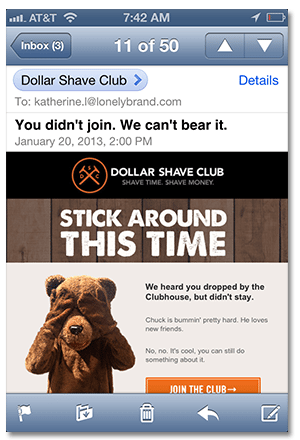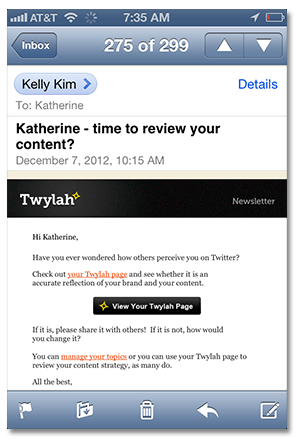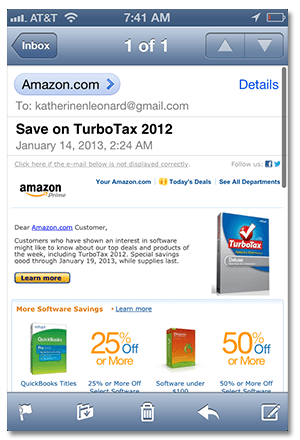Newsletter signups are golden, but they’re certainly not the end of the road. If users aren’t taking the next desired course of action — whether that’s completing the signup process or following through with a purchase — email is the perfect opportunity to remind them to act. From personalization to humor, there are several approaches you can take to re-engage customers via email.
Strategy 1: You missed a step
As with most of its other marketing materials, Dollar Shave Club takes the humor angle when it comes to re-engagement. I signed up for Dollar Shave Club and didn’t take that next step to pay for the service, so one week later they sent out an email to nudge me toward that desired action. From the melodramatic subject line to the pun-laden image, they maintain their brand personality even in a pesky “don’t forget to pay!” email.
If humor fits into your brand’s marketing message, try integrating puns/sarcasm/what have you into re-engagement emails to make them more appealing. And as with most digital content, a clever visual goes a long way.

Strategy 2: Drop the sales-y approach
HootSuite also adds a humorous kick to its re-engagement email. To remind me of a free Twitter Advertising credit, they lead with the subject line, “Umm, were you eaten by alligators?!” As a user, I remember seeing those “$100 Free” emails coming through my email, but neglected to open them because they sounded gimmicky. But something about the alligator query was oddly irresistible.
If previous re-engagement efforts haven’t resulted in any action from the user, there’s a good chance that the offer you’re advertising isn’t appealing to that person. Switch up your strategy and emphasize a different aspect of your brand’s personality such as humour, helpfulness or the gold standard: quality content.

Strategy 3: Remind them of your value
It’s always helpful to craft re-marketing messaging around the user’s needs. Adding their name to the subject line can help, but more importantly, remind them how your product or service can improve their quality of life. In the example below, Twylah cofounder Kelly Kim’s subject line asks, “Katherine – time to review your content?” I couldn’t remember exactly what this meant so I opened the email. The messaging (“see whether your tweets are an accurate reflection of your content”) reminded me why I signed up for the service in the first place.
Subscribers (especially those of us who sit on a computer all day) are bound to sign up for dozens of newsletters, products and services. Rather than assuming that they remember exactly why they forked over a bit of information on your website, take this opportunity to remind them.

Strategy 4: You left this in your cart
A classic trigger for email re-engagement is shopping cart abandonment. Maybe someone changed their mind about buying those three items in their shopping cart — or maybe they opened another tab and completely forgot about the pending transaction. A re-engagement email offers the opportunity to nudge that visitor and say, “Hey, remember this book? You wanted to buy it.”
Behavior-based re-engagement emails are a great task for marketing automation software. For an example of how it works, check out this email from Amazon, as they kindly remind me that I seriously considered purchasing TurboTax 2012 a few days back.

What kinds of strategies have you employed to remind subscribers to perform a certain action?